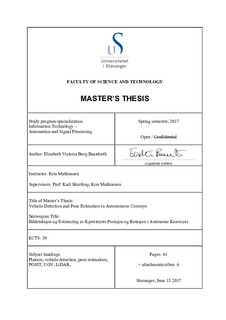Vehicle Detection and Pose Estimation in Autonomous Convoys
Master thesis
Permanent lenke
http://hdl.handle.net/11250/2455922Utgivelsesdato
2017-06-15Metadata
Vis full innførselSamlinger
- Studentoppgaver (TN-IDE) [835]
Sammendrag
Autonomous convoys, also known as platooning, are defined as a group of vehicles driving after one another autonomously. Acting as one single unit the gap between them can be significant reduced and hence the fuel costs compared to conventional driving.
In this thesis a semi-automatic two-vehicle military convoy is studied. Assume the first vehicle remain in control by humans. The second vehicle should then follow it’s track autonomously based on information about the relative distance, position and velocity of the first vehicle. The purpose of this thesis is to find and test methods for vehicle detection and pose estimation.
The methods are mainly based on 3D point cloud data gathered by a LiDAR, but information from cameras are also used. The LiDAR is chosen because of it’s robustness in shifting light and weather conditions, but also because most of today’s research on the field is based on camera vision.
Classifiers based on the leading vehicle’s geometrical properties was found suitable. Also the POSIT method, which combines the imaging coordinates with the corresponding 3D properties provides good results. Distance error was measured to around 15% and orientation deviation to ±4°. For driving that not require millimetre precision the conclusion it that the methods used are well suited. They also have room for improvements as there was several sources of uncertainty in this project.
Beskrivelse
Master's thesis in Cybernetics and signal processing
